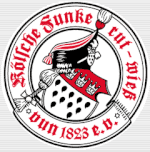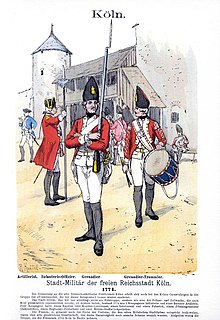Red sparks
| Kölsche Funke rut-wieß from 1823 e. V. (red sparks) |
|
|---|---|
| purpose | Maintenance of traditions and customs of the Cologne Carnival |
| Chair: | Heinz Günther Hunold (President) Wilhelm Stollenwerk (Vice President) Peter Pfeil (Treasurer) |
| Establishment date: | 1823 |
| Seat : | Cologne old town |
| Website: | www.rote-funken.de |
The Kölsche Funke rut-wieß from 1823 e. V. - the Rote Funken for short - are the oldest traditional corps in Cologne's carnival .
founding
The Rote Funken were founded in the same year as the Cologne Carnival Festival Committee , which organizes the Cologne Rose Monday procession, and the large carnival society of 1823 . Sparks wanted as a guard at that time for the hero carnival called Prince Carnival march along the train. Together with the Hellige Knäächten un Mägden they took part in the first Cologne Rose Monday procession on February 10, 1823.
Historical derivation

In terms of name and equipment, they followed on from a troop that had been serving as city soldiers in red uniform jackets and white trousers in Cologne up to 30 years earlier , until they were disbanded by the French marching in on October 6, 1794 or, better still, got lost. They were not particularly well-respected, even poorly paid, so that the soldiers had to knit stockings or look after other people's children for a living. Their food consisted of the cheap onions and garlic ( Kölsch 'Öllig'; Allium ) and kippers (Kölsch 'Böckem'). In addition, they smoked cheap tobacco from a short clay pipe , the uhde (earthen) Nötz . These things still play a role in the tradition of sparks today. The well-fortified city believed itself to be well protected by its walls and therefore believed it could neglect the troops.
Military parody
The carnival soldiers turned this need into a virtue and satirized and caricatured the soldiers who set the tone in Prussian times with their emphatically unmilitary demeanor in command language and forms of exercise. Parades are represented as a dance, where the soldiers her rump dip together in Stippeföttchedanz . Soloists are the dance officer (Funken-Dokter) and his Funkenmariechen . The troop is divided into 4 knobs , which bear the names: Streckstrump (knitted stocking), Öllig (onion), Dopp (the top that was whipped with a whip when looking after children) and Stoppe (champagne cork). The command used today The rifle over! means in Kölsch: De Knabbüß ... reuz! .
history
The Reichstag resolution of 1654 specified the formation of an armed forces. The Reichstag resolution of August 30, 1681 stipulated how much each district had to contribute to the Imperial Army. The Lower Rhine-Westphalian district, which also included the “free imperial city of Cölln”, had to provide 1321 men on horseback and 2708 men on foot as a simple contingent (“Simplum”) according to the imperial register of 1681. The proportion of the "free imperial city of Cölln" was 383 men on foot. In 1784 Caspar Josef Carl von Mylius (born November 11, 1749 in Cologne) was appointed city commander of the troops. The oldest known testimony to the text of the carnival song from the Treuen Hussar , which he is said to have brought from Austria to Cologne, goes back to him . The handwritten version of the text from 1781 was found in his estate in 1929.
At the end of 1822, the 26-year-old lawyer and later District President of Cologne, Johann Heinrich Franz Anton von Wittgenstein, had the idea of setting up a group of Red Sparks. They formed the fifth group in the first Cologne Carnival Monday procession on February 10, 1823. As is not unusual in Cologne, such an institution has perfected itself over time. In 1870 a spark artillery was set up, which later named itself after its blue uniforms Cologne spark artillery blue and white or blue sparks and became independent. In December 1882, "older members" and "proven spark friends" were appointed senators according to the record book found by the board. In addition to providing support for events, official occasions and external functions, the Senators subsequently gave important impulses in many matters of the Corps and promoted its development in many ways. The most traditional corps of the Cologne Carnival began at that time with the tight, Prussian military organization, which has been perfected over the years. Divided into four groups ("Knubbel": "Streckstrump", "Öllich", "Dupp" and "Stoppe") they are led by four Knubbelführer ("Knubbelföhrer"), each of whom has a strict hierarchical structure (e.g. " Oberfunk "," Funke-Weibel "or" Scharschant "). A legitimation paper from 1909 shows that the sparks already had these four knobs back then. The President of the Senate has been a permanent member of the Rote Funken board since 1930. After the Second World War , there was still no Rose Monday procession in 1948, but the sparks marched through the streets - cheered by around 2500 people - and thus celebrated their 125th anniversary. On November 11, 1955, they were the first carnival company to move into Gürzenich, which had been freed from war damage, with a torchlight procession . In the same year they began to excavate what would later become the Funkenquartier , the Ulrepforte (Kölsch 'Ülepooz'). The city of Cologne gave the company the medieval Torburg in leasehold . Even the mayor at the time, Theo Burauen , who later received the red-spark name General "Flintenbein" as Lord Mayor, helped out. The move took place on September 30, 1956. On September 30, 1961, they first took part in the New York Steuben Parade . With the express permission of the Kölschen Funken, an association of German-Americans has been allowed to adorn itself with the official title "Kölsche Funken rut-wieß vun 1823 since 1961 in New York". American enthusiasm for the Cologne Corps went so far that, at least in the early years, uniforms were made to measure in Cologne and then sent to New York.
Today the red sparks are divided into active and inactive sparks as well as the group of spark conveyors. According to the statutes, the respective mayor of the city is automatically a member of the active corps. As a result, Henriette Reker was officially accepted in January 2016 . She is the first female member since the existence of the spark and received the nickname "Agrippina Colonia" in reference to the Roman colony from which the city of Cologne developed.
The spark envy
The soldiers are sworn in during the corps roll call . The funk envy is depicted on a plaque donated in 1977 at the Rote-Funken-Platz in the Martinsviertel near the fish market in Cologne's old town, together with a relief of spark marieches and two cupping sparks. You don't just step into the sparks, after a two-year internship you need two guarantors ( sponsors ) from the group of active / inactive sparks to justify and approve the admission before the ballotage committee . Every active funk receives a nickname from the president when he is sworn in , which reflects a characteristic of the person recorded. He keeps this until he "falls from the stalk".
|
|
literature
- Elisabeth Mick: Die Roten Funken, from city soldiers to the carnival club , Ritterbach Verlag 2007
- Heinz-Günther Hunold, Winfried Drewes, Michael Euler-Schmidt: From City Soldiers to Red Sparks - Military and Carnival in Cologne. Greven Verlag, Cologne, November 2005
- Helmut Signon, Stefan Volberg: The Red Sparks of Cologne ; Kölsche Funke rut-wieß from 1823 e. V., 1989
- Et hät jefunk - 175 years of Rote Funken. Kölsche Funke rut-wieß from 1823 e. V., 1998
- Günther Ortmann: Dreimol vun Hätze: Kölle Alaaf . 1st edition. JP Bachem, Cologne 2004, ISBN 3-7616-1780-1 , p. 653 .
Individual evidence
- ↑ The Urtext of the Cologne “National Anthem”? Communicated by Peter Paul Trippen in the Kölner Stadt-Anzeiger of November 10, 1929, No. 570/4 ( online on the website of the Kölner Husaren-Korps from 1972 e.V .; PDF; 141 kB)
- ↑ Our story. Retrieved February 20, 2020 .
- ^ Regimental roll call in the Maritime: Henriette Reker becomes the first Red Funkin in Cologne. Kölner Stadtanzeiger, January 13, 2016, accessed on March 6, 2017.








